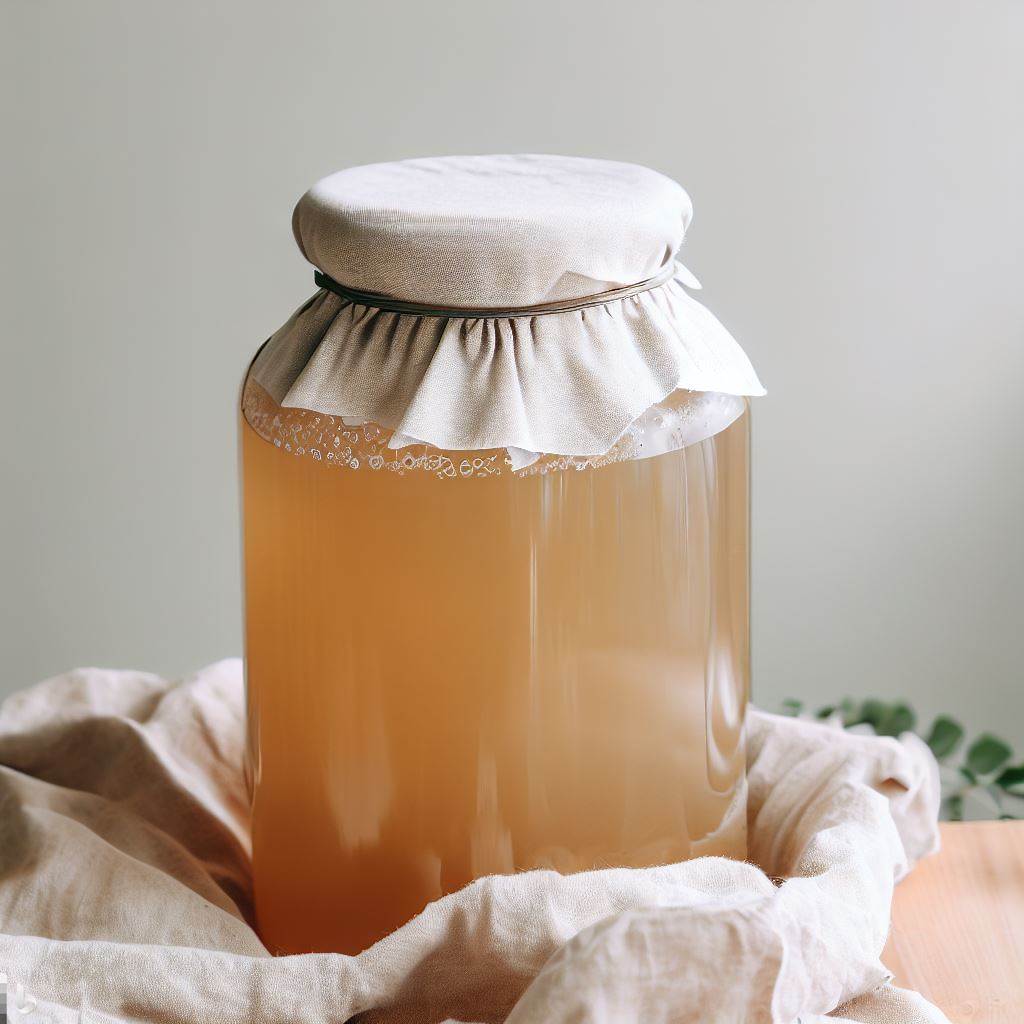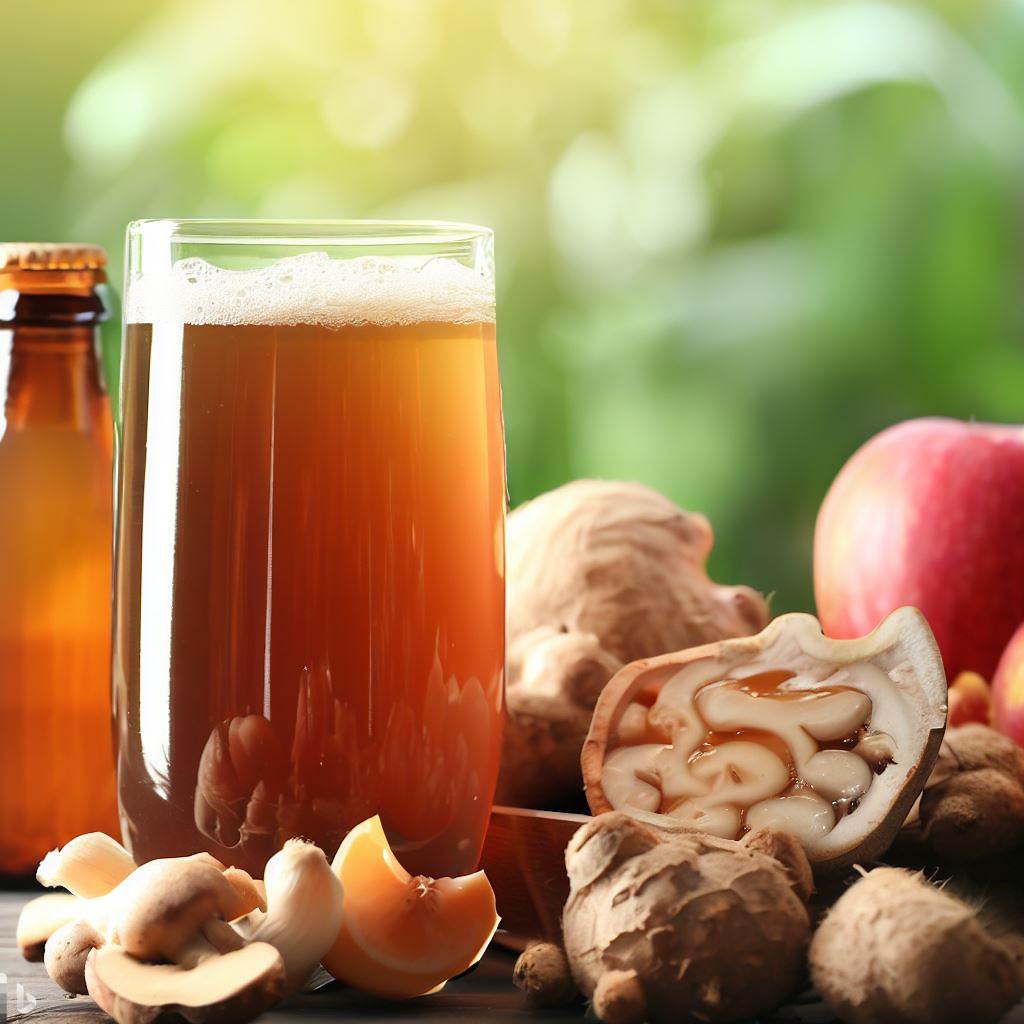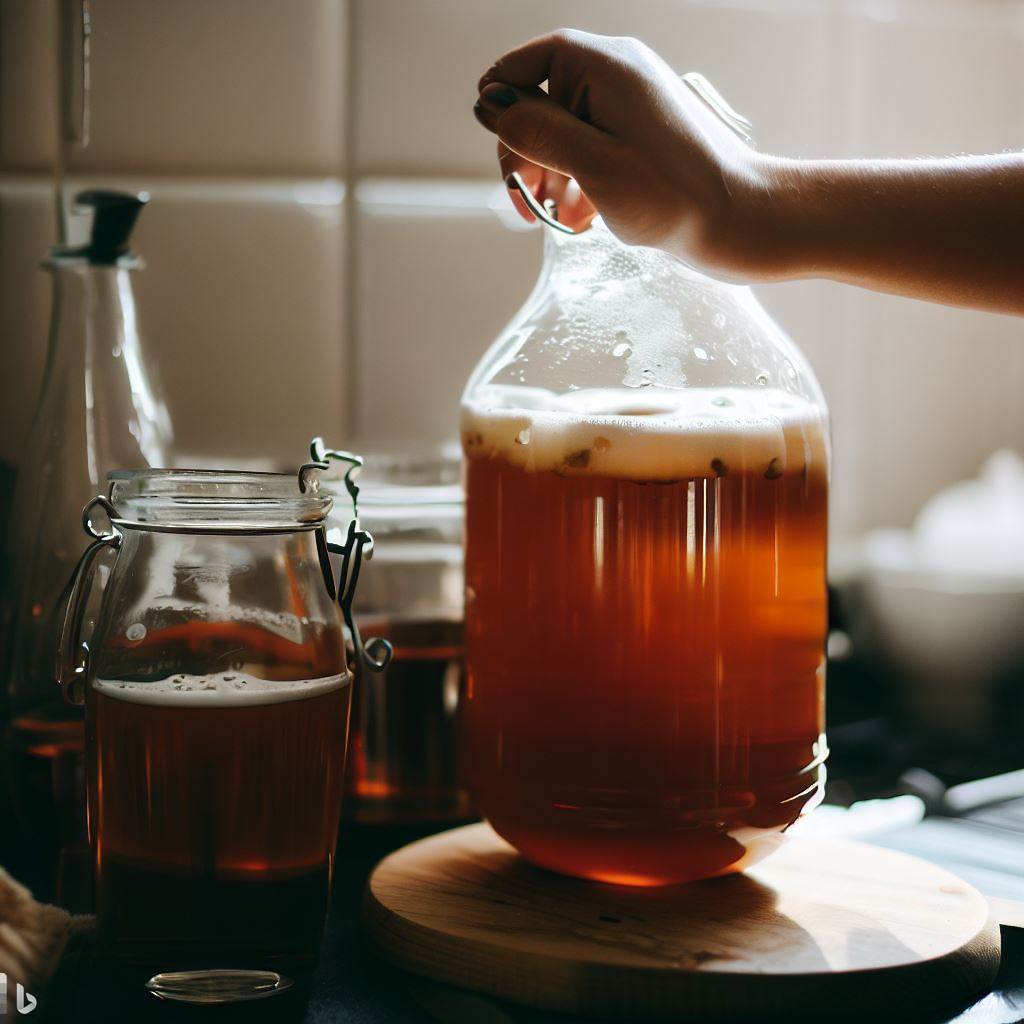Kombucha is a fermented tea beverage that has gained popularity in recent years for its tangy flavor and potential health benefits. It is made by combining sweetened tea with a symbiotic culture of bacteria and yeast (SCOBY). The SCOBY consumes the sugar in the tea and produces various organic acids, vitamins, and other compounds during the fermentation process, resulting in a fizzy, probiotic-rich drink. Now that we have the basics out of the way, in this article we will delve deep into understanding the Science behind Kombucha.
Unravelling the Science Behind Kombucha in this Comprehensive Guide
Although Kombucha’s precise origins are unclear, it is believed to have originated in Northeast China or Russia over 2,000 years ago. It later spread to other parts of Asia and Europe, where it was consumed for its purported health benefits. In recent times, Kombucha has become increasingly popular in Western countries as well.
The Fermentation Process of Kombucha

SCOBY Formation
To begin the fermentation process, a SCOBY is required. The SCOBY, also known as the “mother” or “mushroom,” is a symbiotic colony of bacteria and yeast. It forms a gelatinous layer on the surface of the liquid and serves as the catalyst for the fermentation process.
Sugar Breakdown by Yeast
The yeast strains in the SCOBY consume the sugar in the sweetened tea. They convert the sugar into alcohol through the process of anaerobic fermentation. This alcohol is further broken down by the bacteria present in the SCOBY.
Acetic Acid Production by Bacteria
The bacteria strains, particularly Acetobacter species, play a crucial role in the fermentation process. They convert the alcohol produced by the yeast into acetic acid, which gives Kombucha its characteristic tangy taste. Acetic acid also acts as a natural preservative, preventing the growth of harmful bacteria.
Carbonation and Flavor Development
During the fermentation process, carbon dioxide is produced as a byproduct. This creates natural carbonation in the Kombucha, giving it a pleasant fizziness. Additionally, various compounds are formed during fermentation, contributing to the unique flavors and aromas of different Kombucha varieties.
The Microorganisms in Kombucha

Yeast Strains
Multiple strains of yeast are involved in Kombucha fermentation, including Saccharomyces cerevisiae, Brettanomyces bruxellensis, and Candida stellata. Each strain contributes to the flavor profile and overall character of the fermented beverage.
Bacterial Strains
Kombucha contains several bacterial strains, with the most common being Acetobacter xylinum, Gluconacetobacter kombuchae, and Lactobacillus species. These bacteria play a vital role in breaking down the alcohol produced by the yeast and converting it into beneficial organic acids.
Role of Microorganisms in Fermentation
The symbiotic relationship between yeast and bacteria in Kombucha fermentation is essential for the production of various metabolites. The yeast strains convert sugar into alcohol, while the bacteria transform the alcohol into acetic acid and other beneficial compounds. This synergy creates the characteristic tangy flavor and contributes to the potential health benefits of Kombucha.
Nutritional Composition of Kombucha

Organic Acids
Kombucha is rich in organic acids, including acetic acid, gluconic acid, and lactic acid. These acids contribute to the tangy taste of the beverage and provide potential health benefits. Acetic acid, in particular, has antimicrobial properties and may help support digestive health.
Vitamins and Minerals
The fermentation process of Kombucha enhances its nutritional value. It becomes a natural source of vitamins B1 (thiamine), B2 (riboflavin), B3 (niacin), B6 (pyridoxine), B9 (folate), and B12 (cobalamin). Additionally, Kombucha contains minerals such as iron, zinc, manganese, and copper, which are essential for various bodily functions.
Antioxidants
Kombucha contains antioxidants, such as polyphenols and flavonoids, which help protect the body against oxidative stress and free radicals. These compounds have been linked to potential anti-inflammatory and anticancer properties.
Health Benefits of Kombucha

Digestive Health
Kombucha is often touted for its potential digestive health benefits. The organic acids and probiotics present in Kombucha may support a healthy gut microbiome, aid digestion, and promote regular bowel movements. However, more research is needed to fully understand the mechanisms and extent of these effects.
Immune System Support
The immune system plays a crucial role in defending the body against infections and diseases. Some studies suggest that the antioxidants and probiotics in Kombucha may help strengthen the immune system and reduce the risk of certain illnesses. However, further research is required to confirm these potential immune-boosting effects.
Detoxification
Kombucha has been associated with detoxification due to its potential liver-protective properties. The antioxidants in Kombucha may help neutralize harmful substances and promote the elimination of toxins from the body. However, it’s important to note that the liver is the primary organ responsible for detoxification, and more research is needed to determine the extent of Kombucha’s detoxifying effects.
Potential Antimicrobial Effects
Some studies have indicated that Kombucha may have antimicrobial properties, inhibiting the growth of certain harmful bacteria and fungi. However, the specific mechanisms and the extent of these effects in humans are still under investigation.
Brewing Kombucha at Home

Equipment and Ingredients
Now that you understand the Science Behind Kombucha. To brew Kombucha at home, you will need the following: Or Check out GMK’s Quickstart guide for details on this process.
- Glass jar or fermentation vessel
- SCOBY (either obtained from a trusted source or grown from a previous batch)
- Tea (preferably black or green tea)
- Sugar (regular white sugar or alternative sweeteners like cane sugar or honey)
- Filtered water
- Breathable cloth or coffee filter to cover the jar
- Rubber band to secure the cover
Step-by-Step Brewing Process
- Boil water and steep the tea: Bring water to a boil and add tea bags or loose tea leaves. Steep the tea for the recommended time and remove the tea bags or strain the leaves.
- Dissolve sugar in the tea: Add the desired amount of sugar to the hot tea and stir until completely dissolved. The sugar provides the necessary fuel for the fermentation process.
- Cool the sweetened tea: Allow the sweetened tea to cool to room temperature. It’s crucial to cool it completely before adding the SCOBY to avoid damaging the microorganisms.
- Add SCOBY and starter liquid: Gently place the SCOBY on the surface of the cooled tea, along with some liquid from a previous batch or store-bought Kombucha. The starter liquid helps kickstart the fermentation process.
- Cover and ferment: Cover the jar with a breathable cloth or coffee filter, secured with a rubber band. Place the jar in a warm and dark location away from direct sunlight. Allow the Kombucha to ferment for 7 to 14 days, depending on your desired taste and the temperature.
- Taste and test for readiness: After the initial fermentation period, taste a small amount of Kombucha using a clean spoon. If it’s too sweet, allow it to ferment for a few more days. If it’s too tangy for your liking, the fermentation period can be shorter in the future.
- Bottle and carbonate (optional): Once the Kombucha reaches your desired taste, carefully remove the SCOBY and reserve some liquid as a starter for the next batch. Bottle the Kombucha in glass containers, leaving some headspace for carbonation, if desired. Seal the bottles and allow them to sit at room temperature for a couple of days to build up carbonation. Then, refrigerate to slow down fermentation.
Common Mistakes to Avoid
- Using improper brewing containers (avoid metal containers as they can react with the acidic nature of Kombucha)
- Contamination from unclean equipment (maintain good hygiene and cleanliness throughout the brewing process)
- Inconsistent temperature control (try to keep the fermentation environment as stable as possible)
- Overfermenting or underfermenting (taste the Kombucha regularly to determine the desired level of fermentation)
- Failing to reserve enough starter liquid and SCOBY for future batches (always set aside some liquid and SCOBY for continuity)
Kombucha Variations and Flavors

Fruit Infusions
One of the great things about Kombucha is its versatility. You can experiment with different fruit infusions to add new flavors and aromas to your brew. Here are a few popular fruit combinations to try:
- Strawberry and basil
- Raspberry and mint
- Pineapple and ginger
- Blueberry and lavender
To infuse the flavors, simply add the fruits and herbs to your bottled Kombucha during the secondary fermentation stage. Allow them to steep for a day or two before refrigerating.
Herbal Additions
In addition to fruits, you can incorporate herbs and spices to create unique flavor profiles. Some common herbal additions for Kombucha include:
- Chamomile
- Hibiscus
- Rosemary
- Cinnamon
- Lemongrass
Experiment with different combinations and ratios to find your favorite herbal-infused Kombucha.
Experimenting with Tea Types
While traditional Kombucha is made with black or green tea, you can explore other tea varieties to achieve different flavors and characteristics. Some tea options to consider are:
- White tea: Offers a delicate and slightly sweet taste.
- Oolong tea: Adds a more complex flavor with hints of fruitiness and floral notes.
- Pu-erh tea: Provides a rich and earthy taste, often aged for enhanced complexity.
Feel free to mix and match tea types to find the perfect combination that suits your taste preferences. Check our our Experiemental Tea section to dig in further on this topic.
FAQ – The Science Behing Kombucha

Q: Is Kombucha safe for everyone to consume?
A: Generally, Kombucha is safe for most people to consume. However, individuals with compromised immune systems, pregnant or breastfeeding women, and those with specific health conditions should exercise caution. It’s always recommended to consult with a healthcare professional before incorporating Kombucha into your diet.
Q: How much Kombucha should I drink per day?
A: There is no one-size-fits-all answer to this question as individual tolerance and preferences vary. It’s recommended to start with a small amount, such as 4 to 8 ounces per day, and gradually increase if desired. Listen to your body and adjust your consumption accordingly.
Q: Can Kombucha help with weight loss?
A: While Kombucha is low in calories and can be a healthier alternative to sugary beverages, it’s not a magical weight loss solution. Incorporating Kombucha into a balanced diet and active lifestyle may contribute to overall well-being, but it should not be relied upon as the sole method for weight loss.
Q: What are the potential side effects of Kombucha?
A: Although rare, some individuals may experience adverse effects from consuming Kombucha, such as upset stomach, allergic reactions, or excessive gas. It’s important to start with small amounts and observe how your body responds. If you experience any concerning symptoms, discontinue consumption and consult a healthcare professional.
Q: Can I make Kombucha with alternative sweeteners?
A: Yes, you can use alternative sweeteners like cane sugar or honey to make Kombucha. However, it’s important to note that certain sweeteners may affect the fermentation process differently, potentially leading to variations in taste and carbonation. It’s recommended to experiment and adjust the quantities based on your preference and the characteristics of the chosen sweetener.
Conclusion
Kombucha is not only a refreshing and flavorful beverage but also a product of a fascinating fermentation process. The symbiotic relationship between yeast and bacteria results in the tangy taste, carbonation, and potential health benefits of Kombucha. Understanding the science behind Kombucha can empower you to brew your own batches at home, explore various flavors, and enjoy the potential advantages this probiotic-rich drink may offer. Thanks for reading The Science Behind Kombucha!
So, grab your SCOBY, choose your tea and flavors, and embark on a Kombucha brewing adventure. Cheers to the science and enjoyment of this ancient elixir! Happy Brewing y’all!
Thank you so much for reading GMK’s The Science Behind Kombucha. Read some other articles that may pique your interest:







